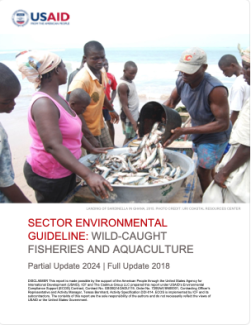The global fish production has grown steadily for decades to a total of 167 million metric tons (MT) in 2014, with fisheries accounting for 93.4 million MT and aquaculture contributing 73.8 million MT. Increasing demand for seafood from developing countries has increased pressure on the sustainability and resilience of both fisheries and aquaculture systems.
USAID investments in wild-caught fisheries and aquaculture (or “farmed” fish) are made in the context of international, national, and agency guidelines, agreements, and policies. These policies represent the governance framework within which USAID projects in the fisheries and aquaculture sector are designed, implemented, and evaluated for responsible environmental stewardship. USAID’s Wildcaught Fisheries and Aquaculture Sector Environmental Guideline describes these policies and identifies potential environmental impacts in this sector, and potential design and mitigation measures to address them.

